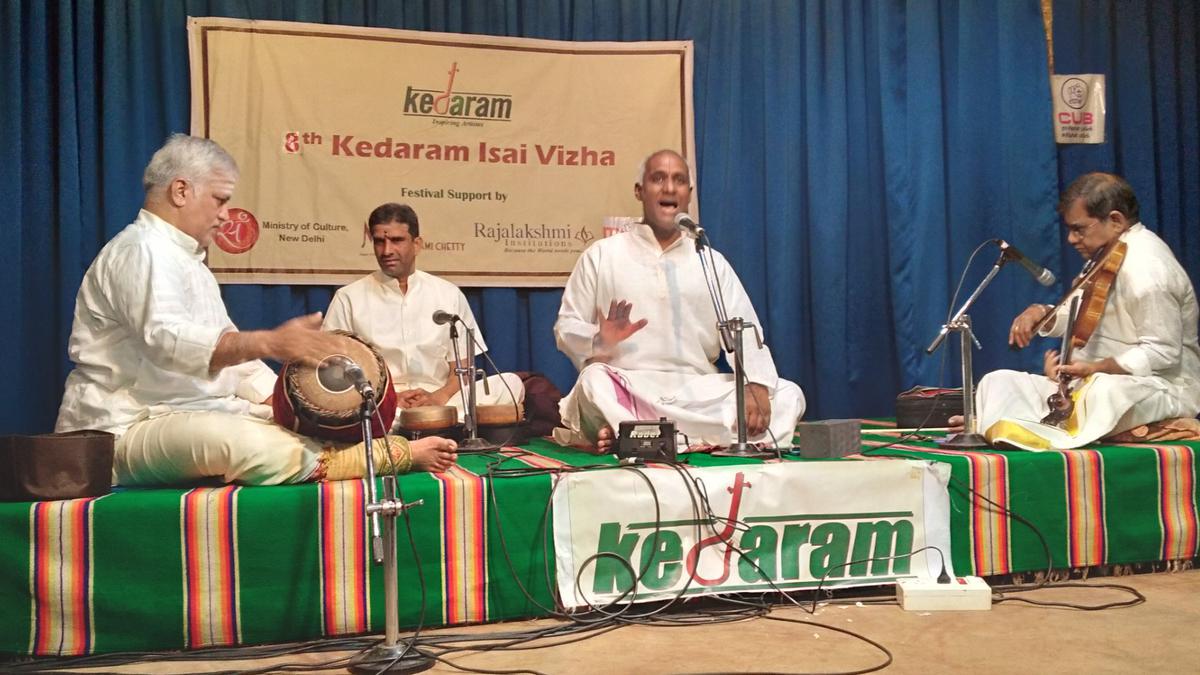
Hemmige Prashanth’s bid to replicate his guru’s style
The Hindu
For his concert, Hemmige Prashant packed kritis from his guru KVN’s repertoire
By stringing together some of the kritis that earned surplus nobility through K.V. Narayanaswamy in the last century, Hemmige S. Prashanth made it tacitly obvious that his concert would be a garland to the guru in his centenary year. The tributary spirit apart, the disciple’s vocals didn’t exactly translate into refreshing music.
Prasanth’s under-use of nasality came clear in the introductory item itself when he negotiated the upper reaches of Vanajakshi varnam. This feature not only distances him from KVN (1923-2002), but deprives the experience of a classical Carnatic soundscape. To his credit, Prashanth has a bold and open voice. That, however, worked as a liability when he sought to soften certain bends along the next piece: ‘Inta paraka’. The sweet timidity of Nadanamakriya merits such an exercise, where the singer tended to slip instead of being mellow. Nonetheless, the swara sequences gave the Annamacharya composition the desired peppiness.
A Harikamboji alapana that followed was extremely brief, yet Prashanth wanted the violinist to return his solo. M.R. Gopinath lit up the raga while remaining crispier, as he did all through the two-hour kacheri. The famed Ramanannu brovara followed. While Prashant had to correct his off-key delivery of lokabhi in a second attempt of the pallavi, his emphasis on the ‘h’ in brahmalo down the anupallavi bore a KVN stamp. By now, the lyricism of the three-beat rupaka cycle amplified the role of percussionists Poongulam S. Subramaniam (mridangam) and Alathur Rajaganesh (kanchira).
Next was ‘Koluvaiyunnade’ after a four-minute alapana of Bhairavi. The sarvalaghu patterns made the solfas breezy, but not without straying onto Anandabhairavi a couple of times. Such a blur reappeared when Prashanth’s alapana in Sahana carried streaks of Kedaragowla, ahead of Arunachala Kavi’s ‘Raghavane sharanam’. What’s more, the vocalist really chose Anandabhairavi next, settling for Dikshitar’s ‘Tyagaraja yogavaibhavam’, fairly synonymous with KVN’s rendition. There was better control over the voice, yet tranquility wasn’t a highlight. Even the reposeful Annapurne Visalakshi in Shyama featured animated passages (around toyajasanadi); in fact, seven items packed the show by halfway.
Inta Soukhyamani infused unhurriedness, with the vocalist effectively replicating KVN sangatis in the kriti tuned to kapi. If Kalyani (Pallavi Gopala Iyer’s varnam) had set off the concert, the main raga was no different. Prashanth’s alapana spanned 10 minutes; Gopinathan’s solo version was substantive. Nidhichala deserved more colour, be it along the niraval or swaraprastara. A galloping taniyavartanam matched the majesty of mishrachapu. Swati Thirunal’s Saramaina javali in Bihag was the swansong. Ten kritis overall appealed more to the crowd, owing to the presentation than the number per se.











